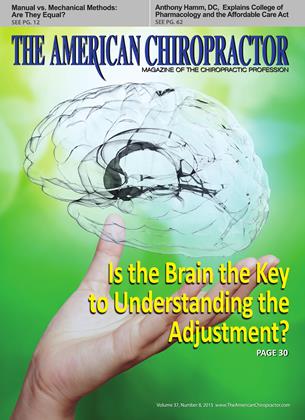“But Doctor, My Foot Doesn’t Hurt!”
BIOMECHANICS
Mark N. Charrette
How often has the chiropractor heard from his or her patient that the area being adjusted “doesn’t hurt”? On the other hand, how often has a patient told us that an area doesn’t hurt, or even feels good, so we decide not to examine it?
There is a huge difference between nonsubluxated and asymptomatic joints. I think most chiropractors would agree, and it is my definite opinion, that many subluxations occur in the absence of any detectable pain. These subluxations can cause many things, including neurological deficits, biomechanical lesions and compensations, and a multitude of symptomatology not necessarily involving pain.
A good example of this is the typical adult with pronated feet. It is interesting to note that most excessive foot pronation does not cause noticeable foot symptomatology. The most common adult pattem is one that involves bilateral but asymmetrical excessive foot pronation, internal tibial and femoral rotation, and some degree of pelvic tilting and anterior translation.
Neurologically, this condition can cause proprioceptive changes and muscular imbalances, which is why the chiropractor may notice a foot that is longer, wider, and flatter and may exhibit:
• Foot flare/toe out
• Excessive posterior/lateral heel wear • Achilles tendon bowing • Patellar rotation
• Visible decrease of the medial longitudinal arch
A good way to demonstrate to the patient that his or her feet may be involved in knee, hip, or low back symptomatology is by using what I refer to as the following “show and feel” demonstration:
Have the patient stand with the feet shoulder width apart. Place the four finger pads of each hand along the bony prominences of the greater trochanter. Next, have the patient roll the feet inward (excessive pronation) and then outward (exces-
sive supination). Do this several times. The patient will notice that the hip joints move more than he or she would think. The second part of this demonstration is to have the patient touch only one trochanter with his or her finger pads. This time have the patient roll the foot inward and outward only slightly. The patient is usually surprised by how much the hip socket moves. This shows that even slight motion of the foot can cause the knee and hip to move and potentially cause symptoms.
This demonstration is an easy initial way to suggest that stabilization of the patient’s feet will help overall structural well-being. Stabilization of excessive pronation can be achieved by custom-made, functional orthotics. I recommend styles that support all three arches of the foot within their normal ranges and allow for flexible locomotion.
In conclusion, my very strong recommendation is for chiropractors not to confuse an asymptomatic joint with a nonsubluxated joint. They aie very different. The subluxated but asymptomatic joints must be examined, adjusted, stabilized, and rehabilitated appropriately.
Dr. Mark Charrette is a 1980 summa cum laude graduate of Palmer College of Chiropractic. He is a frequent guest speaker at Chiropractic colleges worldwide and has taught over fourteen hundred seminars worldwide on extremity adjusting, biomechanics, and spinal adjusting techniques.
Contact info: [email protected]
 View Full Issue
View Full Issue






